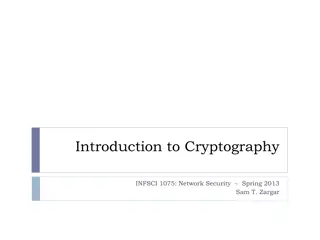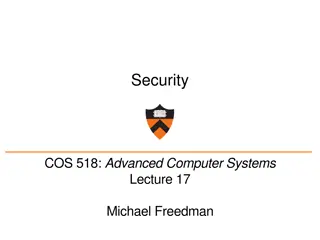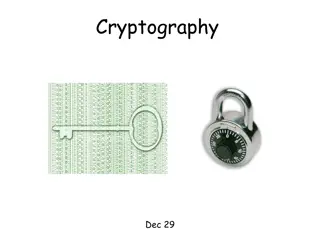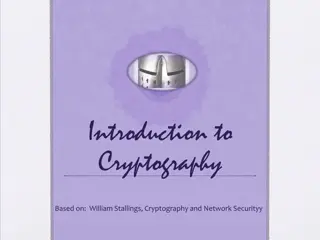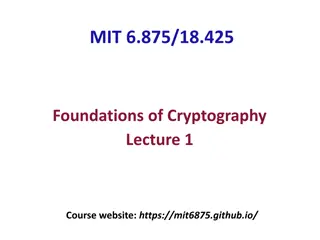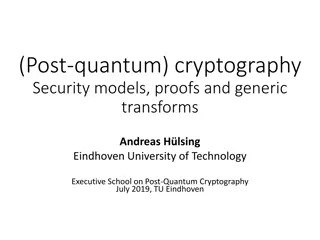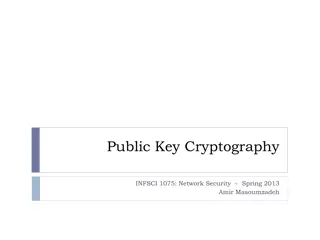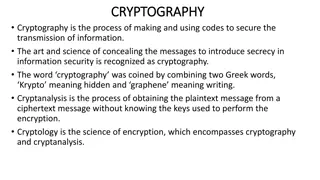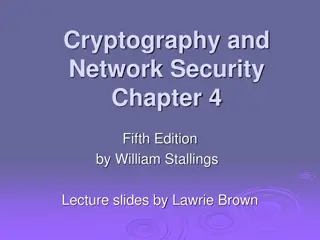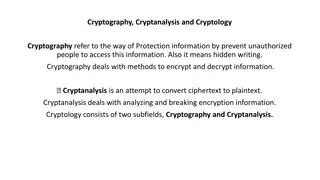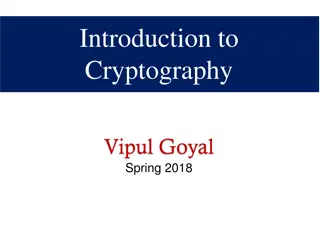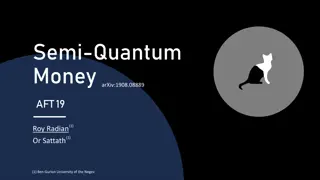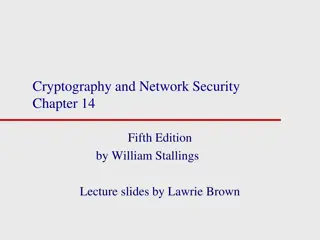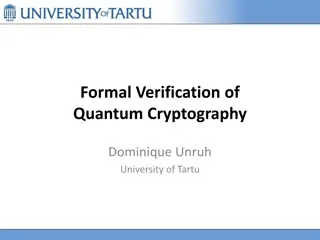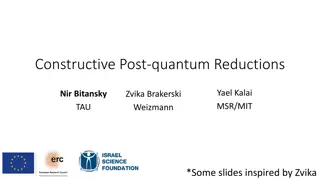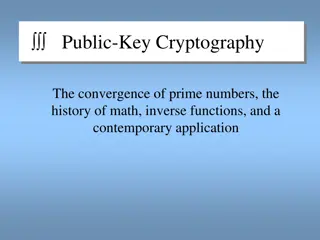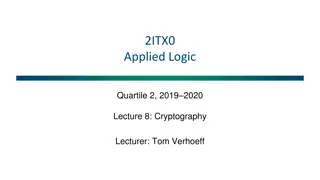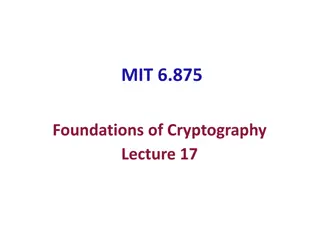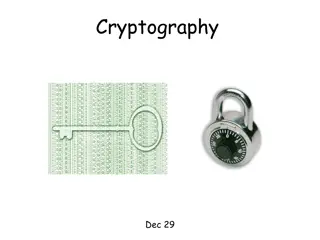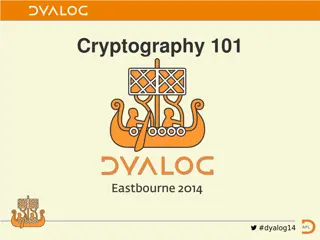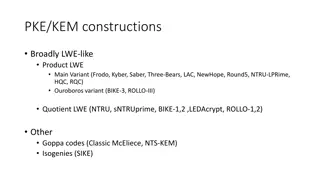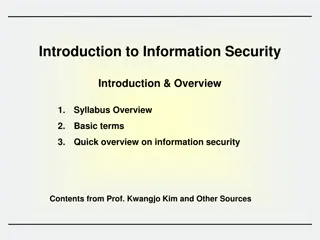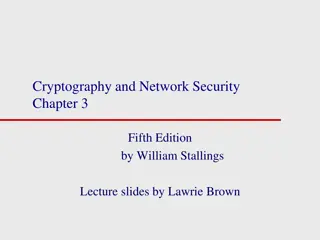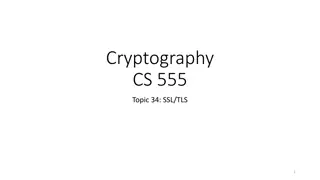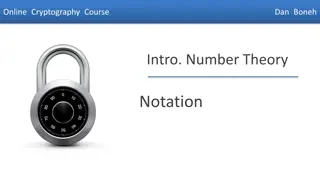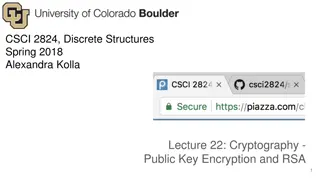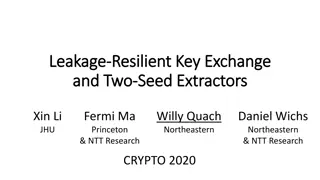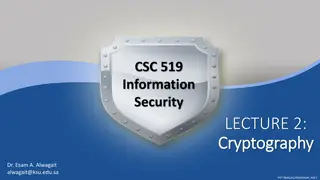Understanding Number Theory and Cryptography for Security
Explore the significance of number theory in cryptography, focusing on modular arithmetic, divisors, prime numbers, and theorems related to them. Discover how encryption algorithms rely on large integers and techniques to handle them effectively, along with primality testing theorems and time complexity considerations.
Download Presentation

Please find below an Image/Link to download the presentation.
The content on the website is provided AS IS for your information and personal use only. It may not be sold, licensed, or shared on other websites without obtaining consent from the author. Download presentation by click this link. If you encounter any issues during the download, it is possible that the publisher has removed the file from their server.
E N D
Presentation Transcript
CS 2210:0001Discrete Structures Modular Arithmetic and Cryptography Fall 2018 Sukumar Ghosh
Preamble Historically, number theory has been a beautiful area of study in pure mathematics. However, in modern times, number theory is very important in the area of security. Encryption algorithms heavily depend on modular arithmetic, and our ability (or inability) to deal with large integers. We need appropriate techniques to deal with large numbers.
Examples 77|7 is FALSE (Bigger number can t divide a smaller positive number) 7|77 is TRUE, because 77 = 7.11 24|24 is TRUE 1|2 is TRUE, but 2|1 is FALSE 0|24 is FALSE (No number is divisible by 0), but 24|0 is TRUE, since 0 is divisible by every non-zero number
Another theorem Theorem. There are infinitely many prime numbers. Proof. Suppose it is not true, and let complete set of primes that we have. Then be the any of the known primes p1-pn. We can thus conclude that is a number that is not divisible by (1) Either Q is a prime, or (2) Q has a prime factor that does not belong to the known set of primes. Either way, we discover one more new prime. So the set of prime numbers must be infinite.
Time Complexity The previous algorithm has a time complexity O(n) (assuming that a|b can be tested in O(1) time). For an 8-digit decimal number, it is thus O(108). This is terrible. Can we do better? Yes! Try only smaller prime numbers as divisors.
Primality testing theorem Proof (by contradiction). Suppose the smallest prime factor p is greater than Then n = p.q where q > p and p > This is a contradiction, since the right hand side > n.
Greatest Common Divisor DEFINITION. Let a, b (a, b 0) be two integers. The greatest common divisor gcd (a,b) is the largest integer that divides both a and b. DEFINITION. a and b are relatively prime (also called co-prime or mutually prime, when gcd (a,b) = 1
Greatest Common Divisor Q: Compute gcd (36, 54, 81)
Euclids gcd Algorithm procedure gcd (a, b) x:= a; y := b (x>y) while y 0 begin r:= x mod y x:= y y:= r end Let a = 12, b= 21 gcd (21, 12) = gcd (12, 9) = gcd (9, 3) Since 9 mod 3 = 0 The gcd is 3 The gcd of (a, b) is x.
Linear Congruence A linear congruence is of the form ax =b (mod m) Where a, b, m are integers, and x is a variable. To solve it, find all integers that satisfy this congruence For example, what is the solution of 3x = 4 (mod 7)?
Discrete Logarithm Consider y = 2x mod 11 (11 is prime) x=1, y=2 x=2, y=4 x=3, y=8 x=4, y=5 x=5, y=10 x=6, y=9 x=7, y=7 x=8, y=3 x=9, y=6 x=10, y=1 Each non-zero value in the set Z11= {0,1,2,3,4,5,6,7,8,9,10} is a value of x for some y. In such a case, 2 is a primitive root of the set Z11= {1,2,3,4,5,6,7,8,9,10} .
Discrete Logarithm A primitive root modulo a prime number p is an integer r in Zp such that every nonzero element of Zp is a power of r
Discrete Logarithm Given 2x (mod 11) = y in the set {1,2,3,4,5,6,7,8,9,10} , you can find a unique value of x for a given y. We will say that x is the discrete logarithm of y (mod 11) (to the base 2).
Discrete Logarithm It is easy to compute 2x (mod 11) = y. But it is extremely difficult to solve 2? (mod 11) = y. This is the discrete logarithm problem. For example, how difficult is it to compute g? mod p = q where p is a 100 digit prime number? This is a cornerstone of modern cryptography. It is easy to compute But is is extremely difficult to compute ONE-WAYFUNCTION
The Inverse a mod m has an inverse a', if a.a 1 (mod m). The inverse exists whenever a and m are relatively prime, i.e. gcd (a, m) = 1. Example. What is the inverse of 3 mod 7? Sincegcd (3, 7) = 1, it has an inverse. The inverse is -2
Solution of linear congruence Solve 3x 4 (mod 7) First, compute the inverse of 3 mod 7. The inverse is -2. (-6 mod 7 = 1 mod 7) Multiplying both sides by the inverse, -2. 3x = -2.4 (mod 7) = -8 (mod 7) x = -8 mod 7 = -1 mod 7 = 6 mod 7 = ..
Chinese remainder theorem In the first century, Chinese mathematician Sun-Tsu asked: Consider an unknown number x. When divided by 3 the remainder is 2, when divided by 5, the remainder is 3, and when divided by 7, the remainder is 2. What is x? This is equivalent to solving the system of linear congruences x 2 (mod 3) x 3 (mod 5) x 2 (mod 7)
Chinese remainder theorem Let m1, m2, m3, mn be pairwise relatively prime integers, and a1, a2, , an be arbitrary integers. Then the system of equations x a1 (mod m1) x a2 (mod m2) ... x an (mod mn) has a unique solution modulo m = m1 m2 m3 ... mn [It is x = a1 M1 y1 + a2 M2 y2 + ... + an Mn yn, where Mk = m/mk and yk = the inverse of Mk mod mk]
Chinese remainder theorem Apply the theorem to solve the problem posed by Sun-Tsu: x 2 (mod 3) x 3 (mod 5) x 2 (mod 7) m1=3 m2=5 m3=7 So, m = 3.5.7 = 105 and M1=5.7=35, M2=3.7=21, M3=3.5= 15 M1y1=1 (mod 3), M2y2=1 (mod 5), M3y3=1 (mod 7) So, y1=2 (mod 3), y2=1 (mod 5), y3=1 (mod 7) Therefore, x= 2.35.2 + 3.21.1 + 2.15.1 (mod 105) = 233 (mod 105) = 23 (mod 105)
Fermats Little Theorem* If p is prime and a is an integer not divisible by p, then ap-1 = 1 (mod p) This also means that ap = a (mod p) * Should not be confused with Fermat s Last theorem
Fermats Little Theorem Compute 7222 (mod 11) 7222 (mod 11) = (710)22 . 72 (mod 11) 710(mod 11) =1 (Fermat s little theorem) 7222 (mod 11) = 122.49 (mod 11) = 49 (mod 11) = 5 (mod 11)
More on prime numbers Are there very efficient ways to generate prime numbers? Ancient Chinese mathematicians believed that n is a prime if and only if 2n-1 = 1 (mod n) For example 27-1 = 1 (mod 7) (and 7 is a prime) But unfortunately, the if part is not true. Note that 2341-1 = 1 (mod 341), But 341 is not prime (341 = 11 X 31). (these are called pseudo-prime numbers). When n is composite, and bn-1 = 1 (mod n), n is called a pseudo- prime to the base b
Modular Exponentiation A computationally efficient way to compute ax mod b when x is large. The key idea is to represent x in the binary form first. Example. What is 3133 mod 645? 3133 mod 645 = 310000101 mod 645 = 3128+4+1 mod 645 31 mod 645 = 3, 32 mod 645 = 9, 34 mod 645 = 81 38 mod 645 = 812 mod 645 = 111 364 mod 845 = 1112 mod 645 = 66 3128 mod 845 = 662 mod 645 = 486 So, 3128+4+1 mod 645 = 486.81.3 mod 645 = you calculate
Applications of Congruence Hashing function A hashing function is a mapping 0 1 2 key a storage location (larger domain) (smaller size storage) So that it can be efficiently stored and retrieved. m-2 m-1
Applications of Congruence: Hashing function Assume that University of Iowa plans to maintain a record of its 5000 employees using SSN as the key. How will it assign a memory location to the record for an employee with key = k? One solution is to use a hashing function h. As an example, let it be: 0 1 2 h(k) = k2 mod m (where m = number of available memory locations, m 5000) m-2 m-1
Hashing functions A hashing function must be easy to evaluate, preferably in constant (i.e O(1) )time. There is a risk of collision (two keys mapped to the same location), but in that case the first free location after the occupied location has to be assigned by the hashing function. 0 1 2 Key k1 Collision Key 2 For good hashing functions, collisions are rare. m-2 m-1
Applications of Congruence: Parity Check When a string of n bits b1 b2 b3 bn is transmitted, sometimes a single bit is corrupted due to communication error. To safeguard this, an extra bit bn+1 is added. The extra bit is chosen so that mod 2 sum of all the bits is 0 (for even parity) or 1 (for odd parity). 1 1 0 1 0 1 0 0 1 0 1 1 0 0 1 1 1 Parity checking helps detect such transmission errors. Works for single bit corruption only (even parity bit in red)
Applications of Congruence: Pseudo-random number generation Consider the recursive definition: It generates a pseudo-random sequence (what is this?) of numbers where being the initial seed A popular one is
Private Key Cryptography The oldest example is Caesar cipher used by Julius Caesar to communicate with his generals. For example, LOVE ORYH (circular shift by 3 places) In general, for Caesar Cipher, let p = plain text c= cipher text, k = encryption key (secret) The encryption algorithm is The decryption algorithm is Both parties must share a common secret key.
Private Key Cryptography One problem with private key cryptography is the distribution of the private key. To send a secret message, you need a key. How would you transmit the key? Would you use another key for it? This led to the introduction of public key cryptography
Public Key encryption RSA Cryptosystems uses two keys, a public key and a private key Let (p, q are large prime numbers, say 200 digits each) The encryption key e is relatively prime to (p-1)(q-1), and the decryption key d is the inverse of e mod (p-1)(q-1) (e is secret, but d is publicly known) C = Me mod n Ciphertext M = Cd mod n Plaintext (Why does it work?) Ciphertext C is a signed version of the plaintext message M. Or, Alice can send a message to Bob by encrypting it with Bob s public key. No one else, but Bob will be able to decipher it using the secret key
Public Key encryption C = Me mod n Ciphertext M = Cd mod n Plaintext When Bob sends a message M by encrypting it with his secret key e, Alice (in fact anyone) can decrypt it using Bob s public key. C is a signed version of the plaintext message M. Alice can send a message to Bob by encrypting it with Bob s public key d. No one else, but Bob will be able to decipher it using his secret key e
Example n = 43 x 59 = 2537 (i.e. p = 43, q = 59). Everybody knows n. but nobody knows p or q they are secret. (p-1)(q-1) = 42 x 58 = 2436 Encryption key e = 13 (must be relatively prime with 2436) (secret). Decryption key d = 937 (is the inverse of e mod (p-1)(q-1)) (public knowledge) Encrypt 1819: 181913mod 2537 = 2081 Decrypt 2081: 2081937mod 2537 =1819
Proof of RSA encryption Ciphertext C = Me mod n Cd = Md.e = M1+k(p-1)(q-1) mod n (Here n = p.q) (since d is the inverse of e mod (p-1)(q-1), d.e = 1 mod (p-1)(q-1) = M .(M(p-1))k(q-1) mod n Usually M is not a multiple of p or q, so Cd = M .(M(p-1))k(q-1) mod p = M.1 mod p (Using Fermat s Little Theorem: M(p-1) = 1 mod p) Similarly, Cd = M .(M(q-1))k(p-1) mod q = M.1 mod q
Proof of RSA encryption Cd = M mod p Cd = M mod q Since gcd (p,q) = 1, Cd = M.1 mod p.q (Chinese Remainder Theorem) Cd = M mod n So, Why is it difficult to break into RSA encryption?



